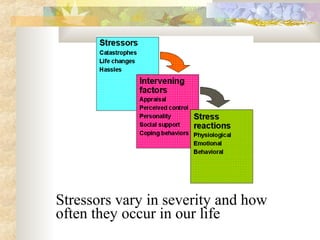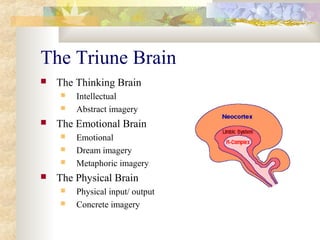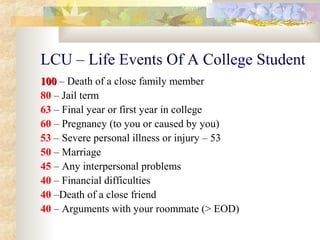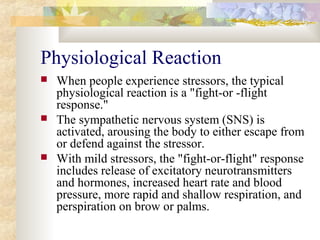Understanding stress (2003)
- 1. Understanding Stress Dr Zahiruddin Othman Jabatan Psikiatri, PPSP Last updated 03/03/03
- 2. Fight Or Flight Phenomenon Cannon, 1939: stress as a "fight or flight" phenomenon ... helps us to mobilize energy to either defeat the stressor or to get away from it Modern stress has more social or psychological stressors than physical stressors An ego-related stressor cannot be reduced by using a physical response (e.g. fight) May also continue over a longer time than a physical stressor An imagined stressor is impossible to fight via physical means
- 3. Good And Bad Stress Hans Selye, 1956: stressors are part of normal daily life and can be divided into the good and the bad: Eustress Action-enhancing stress which can help in sport or in motivating someone to get moving Distress Either over-reaction or under-reaction, but always associated with confusion, lack of concentration and psychological anxiety
- 4. Eustress is the action-enhancing stress that gives athlete the competitive edge EustressEustress DistressDistress Optimal StressOptimal Stress Health and Performance
- 6. Stressors vary in severity and how often they occur in our life
- 7. Catastrophes Are large-scale events that disrupt the lives of many people and strain or overwhelm community services. Examples include natural disasters such as hurricane, floods, and famine Meteor Collision
- 8. War is a man made disaster – water and sanitation, electricity, food stores, and food supply routes are destroyed
- 9. Major Life Changes Are milestone events in a person's life, which cause substantial change in one's daily routine. Examples include graduating from college, changing jobs, getting married or divorced, breaking up a long-term relationship, having a family member diagnosed with a chronic disease, death of a loved one, moving, becoming a parent, and so on.
- 10. Major life changes happen once or only a few times in a person's life
- 11. Becoming a parent is one of the major life changes
- 12. Daily Hassles Are annoyances encountered in daily life. Examples include traffic problems, differences in lifestyles between roommates, deadlines, expectations of parents or teachers, bills and money problems, bad weather, car problems, and so on.
- 13. Daily hassles are not necessarily encountered everyday but represent disruptions of or annoyances to one's daily routine
- 14. Intervening factors filter and modify the stressors
- 15. Intervening Psychological Factors The way individuals perceive stressors can influence physiological reactions and subsequent development of real physical illness. Some examples of factors that influence how people perceive stress, which in turn affect health, include Perceived Control Type A Personality Social Relationships Lifestyle and Habits
- 16. Appraisals occur at subconscious and conscious level
- 17. The Triune Brain The Thinking Brain Intellectual Abstract imagery The Emotional Brain Emotional Dream imagery Metaphoric imagery The Physical Brain Physical input/ output Concrete imagery
- 18. Emotions, Thoughts And Beliefs Emotions Usually the result of thoughts e.g. anger, fear, joy, guilt, jealousy, love, courage, sadness Thoughts Conscious thought operates as a control system e.g. focus on some goal leads to action for accomplishment of the goal Conscious mind chooses behaviors in order to handle overload e.g. withdrawing from a situation which is too difficult e.g. being depressed or miserable Beliefs Beliefs are thoughts which endure over time Learned early in life from others Help to what we do and how we evaluate what we do
- 19. Core Beliefs And Negative Automatic Thoughts Core Beliefs + Stressor I am unlovable + break-up with boyfriend Automatic Thoughts + Thinking Errors = Negative Automatic Thoughts Personalizing, magnifying & minimizing etc Negative Emotions Depression
- 20. Optimistic Explanatory Style Perceived control lead to longer life (Seligman's study of baseball players) and greater job success (Seligman's life insurance salesman study) Attributions (explanations about past events) & optimism or expectations about the future Global, stable & internal dimensions Positive events with global stable, & internal attributions + negative events with specific, unstable, and external attributions seem to promote optimism
- 21. Perceived Control Attribution Internal or external Stable or unstable Global or specific Locus of control Internal or external
- 22. Attributions For Negative Events
- 23. Pessimistic Explanatory Style Seligman's executive monkey, dog, rat studies Lack of control led to ulcers, failure to learn in new situation when control was possible Loss of perceived control leads to learned helplessness
- 24. Coping Styles Emotional-based coping Focus on emotions due to stress i.e. stress reaction Problem-based coping Focus on the events causing stress i.e. stressors What happen in learned helplessness? Pessimism no action GAS: alarm resistance exhaustion
- 25. Characteristics of a Type A Behavior Pattern Hurry sickness A sense of time urgency; trying to accomplish too much in too little time. Quest for numbers Preoccupied with ratings, being better than others, earning more money, etc. Insecurity of status Strong need for "objective" measure of self-worth, pursues achievement to get admiration from others. Aggression & hostility Competes with or challenges others continually; struggles to beat others, quick-tempered and angry
- 26. Type A personality individual is preoccupied with ratings, being better than others, earning more money, etc.
- 27. Aggressive or Passive Aggressiveness Demanding Does not consider the other person's self esteem Belittles the other person (e.g. they are "dumb" for not agreeing) Usually results in counter-aggression Communication usually blocked ... everyone leaves dissatisfied Non-assertiveness = NOT saying what you feel ... being passive Might sit back and hope that others will notice their needs Might use manipulation
- 28. Practice Assertiveness Being assertive (Albert & Emmons, 1995) OK to say no ... no guilt OK to change your mind OK to take your time before doing something OK to ask for further instructions OK to demand respect OK to do less than you can do OK to express your feelings OK to feel good about yourself ... whenever ... wherever
- 29. Being assertive means saying what you feel but not being aggressive
- 30. Psychosocial Factors Relations between people and other people Same events interpreted differently by different individuals Adaptation Overload Frustration Deprivation Trauma
- 31. Social Readjustment Rating Scale (Holmes & Rahe) Concept of a "life change unit" (LCU) which could be large (e.g. death of a spouse = 100 LCU's) or small (e.g. violation of the law = 11 LCU's) Any kind of change (good news or bad news) requires adaptation NB: of course, bad news is generally harder to take because it involves fear, self doubt and other emotions There are individual differences in the perception of events (e.g. good or bad news): Since novelty is stressing, having had an experience before helps one to adapt to it again However, some events are stressing regardless of previous experience (e.g. moving)
- 32. LCU – Life Events Of A College Student 100100 – Death of a close family member 80 – Jail term 63 – Final year or first year in college 60 – Pregnancy (to you or caused by you) 53 – Severe personal illness or injury – 53 50 – Marriage 45 – Any interpersonal problems 40 – Financial difficulties 40 –Death of a close friend 40 – Arguments with your roommate (> EOD)
- 33. LCU – Life Events (2) 40 – Major disagreements with your family 30 – Major change in personal habits 30 – Change in living environment 30 – Beginning or ending job 25 – Problem with your boss or professor 25 – Outstanding personal achievement 25 – Failure in a course 20 – Final exams 20 – Increase or decrease dating 20 – Change in working conditions
- 34. LCU – Life Events (3) 20 – Change in your academic major 18 – Change in your sleeping habits – 15 – Several-day vacation – 15 – Change in eating habits 15 – Family reunion 15 – Change in recreational activities 15 – Minor illness or injury 11 – Minor violations of the law
- 35. Interpreting The Scale Predictor of physical and mental illness for a-two year period after the accumulation of the stressors i.e. Total LCU in 12 months Level of life change stress Low: < 150 Moderate: 150 – 300 High: > 300:
- 36. Frustration When we are prevented from achieving our goals, we become frustrated Discrimination Bureaucracy Socioeconomic factors Responses to frustration Anger and aggression Nervous and hormonal response (i.e. the stress response)
- 37. Overload Demands > capacity Can arise from a variety of sources: Time pressures Too much responsibility/accountability Lack of support Expectations which are too high
- 38. Occupational Overload Sources of occupational overload Responsibility/accountability Lack of managerial/subordinate support Unreasonably high role expectations Air traffic controllers Example too much occupational overload Stress-related diseases - hypertension, peptic ulcers, diabetes Grayson, 1972: 32.5% suffering from gastrointestinal ulcers
- 39. Deadlines are common source of occupational overload
- 40. Academic Overload Demands on teachers (Cooper, 1995) Research, community service, teaching, advising, parent-student counseling, etc. Demands on students Competition for entry into university (then entry into graduate school) Admissions tests Need for mental health counseling in educational institutions
- 41. Deprivational Stress Boredom Could be due to monotonous tasks, unchallenging work Boredom and depression are major adolescent health problems Loneliness Not enough care and attention to children stimulus deprivation Lynch, 1977: rate of heart disease, cancer and auto accidents higher in single, widowed and divorced individuals. Unmarried men 45-54 years = 123% higher death rate than married men
- 42. Bioecological Factors Interpreted more or less the same by different people Time and body rhythm Eating and drinking habit Drugs Noise pollution Climate and altitude
- 43. Stress reactions occur at various levels – physiological, emotional, and behavioral
- 44. Physiological Reaction When people experience stressors, the typical physiological reaction is a "fight-or -flight response." The sympathetic nervous system (SNS) is activated, arousing the body to either escape from or defend against the stressor. With mild stressors, the "fight-or-flight" response includes release of excitatory neurotransmitters and hormones, increased heart rate and blood pressure, more rapid and shallow respiration, and perspiration on brow or palms.
- 46. Psychosomatic Health Control of the stress response Autonomic nervous system Endocrine system Control of health and disease Immune system Neuropeptide system
- 47. Sympathetic Nervous System Initiation of the stress response “Fight or flight" energizing increased HR increased stroke volume constriction of blood vessels in gastrointestinal tract deeper and faster breathing pupil dilation adrenalin release from adrenal glands fatty acid release from liver epinephrine, norepinephrine and dopamine release
- 48. Sympathetic nervous system is activated during “fight or flight” response
- 49. Parasympathetic Nervous System Relaxation and termination of the stress response slow down HR expansion of most blood vessels ... increased gastrointestinal activity bronchial constriction pupil constriction salivary increase
- 50. Autonomic Control of the Stress Response Hypothalamus coordinates the body's response to sight, sound, touch, smell and taste i.e. the fact of the reaction Limbic system defines the sensation as being either pleasurable or not pleasurable i.e. the direction of the reaction RAS defines the degree to which something is either pleasant or unpleasant i.e. the degree of the reaction Cortex either boosts the present state, or attenuates it i.e. on the basis of what is reasonable or how it is related to other memories
- 51. The Adrenal Glands Adrenal Medulla Neuronal stimulation from hypothalamus Secretes epinephrine (adrenalin), norepinephrine, dopamine Adrenal Cortex Stimulated by ACTH Secretes glucocorticoids (cortisol): Increases energy availability via gluconeogenesis in the liver Suppress immune system High levels of fatty acids contribute to atherosclerosis Secretes aldosterone: Sodium and water retention ... better heat/waste dissipation Problem - increased blood volume and BP ... more work for the CV system
- 52. General Adaptation Syndrome Alarm Phase Initial response to a stressor Increased ACTH from pituitary gland Stimulation of adrenal glands Fight or flight response Generalized stress arousal Resistance Phase Channeling of arousal response to a specific organ Decreases in ACTH Arousal of a specific organ system ... eventual fatigue and malfunction Adaptation to stress eventually becomes a disease in itself
- 53. General Adaptation Syndrome Exhaustion Phase: Specific organ system involved in the resistance phase breaks down Increased ACTH again Exhaustion, malfunction or death
- 55. Responses To Stress Body Psychosomatic illness e.g. essential hypertension, tension headache Mind Mental illness e.g. depression, anxiety etc Behavioral Ineffective coping styles e.g. conduct problem, drug addiction
























































